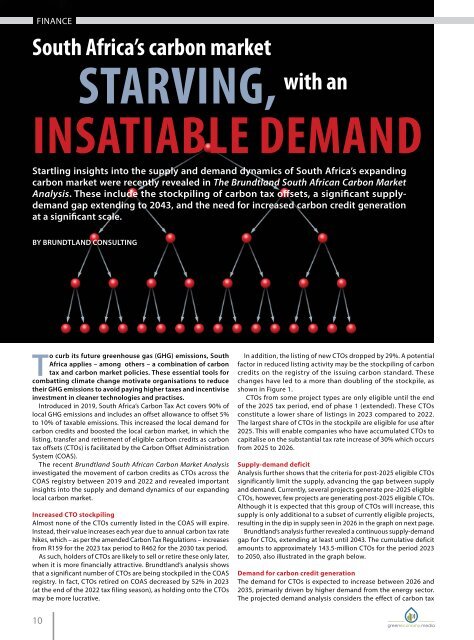Green Economy Journal Issue 63
Create successful ePaper yourself
Turn your PDF publications into a flip-book with our unique Google optimized e-Paper software.
FINANCE<br />
South Africa’s carbon market<br />
STARVING,<br />
with an<br />
COAS listings<br />
(million CTOs/year)<br />
COAS stockpile<br />
(million CTOs/year)<br />
COAS retirements<br />
(million CTOs/year)<br />
FINANCE<br />
INSATIABLE DEMAND<br />
Figure 1. The flow of CTOs through COAS over time.<br />
Startling insights into the supply and demand dynamics of South Africa’s expanding<br />
carbon market were recently revealed in The Brundtland South African Carbon Market<br />
Analysis. These include the stockpiling of carbon tax offsets, a significant supplydemand<br />
gap extending to 2043, and the need for increased carbon credit generation<br />
at a significant scale.<br />
BY BRUNDTLAND CONSULTING<br />
on the energy and industrial sectors, as they will aim to reduce<br />
their emissions by 5% to 10% through using CTOs. The demand<br />
projection also considers the implication of South Africa’s Nationally<br />
Determined Contribution (NDC) and assumes a linear trajectory to<br />
net-zero emissions in 2050.<br />
This illustrates that there is a need for increased carbon credit<br />
generation at a significant scale. It is crucial to acknowledge that<br />
engaging in projects that generate carbon credits can be challenging,<br />
considering the expertise required for project implementation,<br />
the complexity to measure and verify emission reductions and the<br />
regulatory compliance requirements. Further, the eligibility criteria<br />
for carbon credits under the South African Carbon Tax is restrictive, for<br />
example, excluding activities that had received an energy efficiency<br />
allowance under section 12L of the Income Tax Act.<br />
At the leading edge<br />
The supply and demand dynamics of South Africa’s expanding carbon<br />
market will affect many local companies as they face increasing<br />
carbon taxes and tougher competition for the already-tight supply<br />
of CTOs that will be in ever-greater demand.<br />
CTO supply-demand gap (million CTOs/year)<br />
To curb its future greenhouse gas (GHG) emissions, South<br />
Africa applies – among others – a combination of carbon<br />
tax and carbon market policies. These essential tools for<br />
combatting climate change motivate organisations to reduce<br />
their GHG emissions to avoid paying higher taxes and incentivise<br />
investment in cleaner technologies and practises.<br />
Introduced in 2019, South Africa’s Carbon Tax Act covers 90% of<br />
local GHG emissions and includes an offset allowance to offset 5%<br />
to 10% of taxable emissions. This increased the local demand for<br />
carbon credits and boosted the local carbon market, in which the<br />
listing, transfer and retirement of eligible carbon credits as carbon<br />
tax offsets (CTOs) is facilitated by the Carbon Offset Administration<br />
System (COAS).<br />
The recent Brundtland South African Carbon Market Analysis<br />
investigated the movement of carbon credits as CTOs across the<br />
COAS registry between 2019 and 2022 and revealed important<br />
insights into the supply and demand dynamics of our expanding<br />
local carbon market.<br />
Increased CTO stockpiling<br />
Almost none of the CTOs currently listed in the COAS will expire.<br />
Instead, their value increases each year due to annual carbon tax rate<br />
hikes, which – as per the amended Carbon Tax Regulations – increases<br />
from R159 for the 2023 tax period to R462 for the 2030 tax period.<br />
As such, holders of CTOs are likely to sell or retire these only later,<br />
when it is more financially attractive. Brundtland’s analysis shows<br />
that a significant number of CTOs are being stockpiled in the COAS<br />
registry. In fact, CTOs retired on COAS decreased by 52% in 2023<br />
(at the end of the 2022 tax filing season), as holding onto the CTOs<br />
may be more lucrative.<br />
In addition, the listing of new CTOs dropped by 29%. A potential<br />
factor in reduced listing activity may be the stockpiling of carbon<br />
credits on the registry of the issuing carbon standard. These<br />
changes have led to a more than doubling of the stockpile, as<br />
shown in Figure 1.<br />
CTOs from some project types are only eligible until the end<br />
of the 2025 tax period, end of phase 1 (extended). These CTOs<br />
constitute a lower share of listings in 2023 compared to 2022.<br />
The largest share of CTOs in the stockpile are eligible for use after<br />
2025. This will enable companies who have accumulated CTOs to<br />
capitalise on the substantial tax rate increase of 30% which occurs<br />
from 2025 to 2026.<br />
Supply-demand deficit<br />
Analysis further shows that the criteria for post-2025 eligible CTOs<br />
significantly limit the supply, advancing the gap between supply<br />
and demand. Currently, several projects generate pre-2025 eligible<br />
CTOs, however, few projects are generating post-2025 eligible CTOs.<br />
Although it is expected that this group of CTOs will increase, this<br />
supply is only additional to a subset of currently eligible projects,<br />
resulting in the dip in supply seen in 2026 in the graph on next page.<br />
Brundtland’s analysis further revealed a continuous supply-demand<br />
gap for CTOs, extending at least until 2043. The cumulative deficit<br />
amounts to approximately 143.5-million CTOs for the period 2023<br />
to 2050, also illustrated in the graph below.<br />
Demand for carbon credit generation<br />
The demand for CTOs is expected to increase between 2026 and<br />
2035, primarily driven by higher demand from the energy sector.<br />
The projected demand analysis considers the effect of carbon tax<br />
WATCH VIDEO<br />
Mind the Gap, a deficit of 143.5-million CTOs across the various tax phases.<br />
THOUGHT [ECO]NOMY<br />
greeneconomy/report recycle<br />
THE SOUTH AFRICAN CARBON TAX EXPLAINED |<br />
Brundtland Consulting<br />
10 11

















